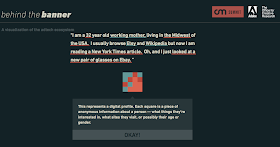 |
| Source: CM Summit & The Office of Creative Research |
It is the invisible web behind the banner, ad, or game that they don’t see that matters. The visualization developed by CM Summit and The Office of Creative Research called Behind the Banner provides an interactive view of how the adtech ecosystem collects data based on search patterns.
 |
| Source: CM Summit & The Office of Creative Research |
It is a fascinating look at the how a digital profile forms based on a piece of anonymous information about a person. The visualization unveils how computers compile a complex network of data to deliver ads tailored to a user's interest and what websites he or she visited. The sheer amount of data can even be customized to target age or gender, and it all takes place in a nanosecond. Most people do not fully understand just how much our privacy is tracked every time we search or share information over digital networks.
 |
| Source: CM Summit & The Office of Creative Research |
For this reason, we keep an open dialog going with our learners. We try to thread connections throughout the curricula areas by revisiting, reinforcing, and reviewing new resources to help them visualize what happens online, particularly regarding privacy. As technologies continue to change, so do the privacy settings. Unless users remain vigilant in checking updates, or reading the fine print of acceptance policies, their privacy can be easily compromised.
We want our students to know our approach is not to be a cop looking to block access. Unlike many of their parents who are not so tech savvy, we know that our students are far more skilled at getting on the web even with parental restrictions. Instead, our objective is to keep the line of communication open about issues of privacy, opportunities lost over poor judgment, and techniques used to track personal information online.
To help younger children understand digital ads, we recommend the video, What Does The Ad Say?, from the Internet Advertising Bureau in the UK. This short, educational video is perfect for helping children and parents know how online marketing works and the types of digital markteting techniques used to target users.
For other resources, please see:

This is great. Children should be aware of privacy considerations especially now that they have access to a variety of websites. It's good to know that you are incorporating new strategies to make web browsing a lot safer.
ReplyDeleteGood article. I’m going through many of these issues as well..
ReplyDeleteThis is really interesting, You are a very skilled blogger
ReplyDeleteGood web site you have got here.. It’s hard to find quality writing like yours these days.
ReplyDeleteThank you for the information you provide, it helped me a lot
ReplyDelete